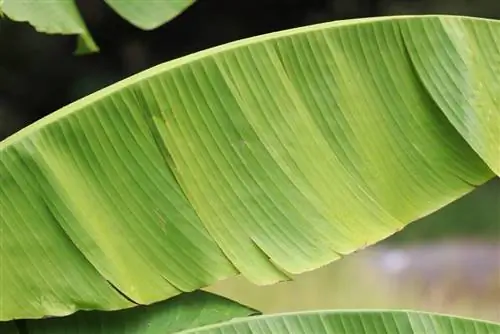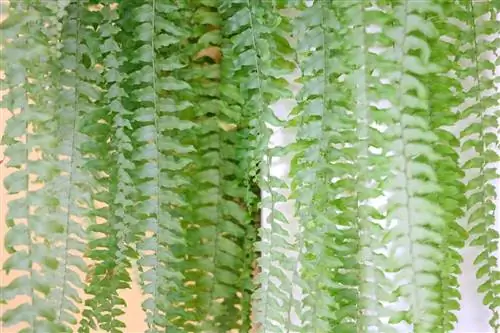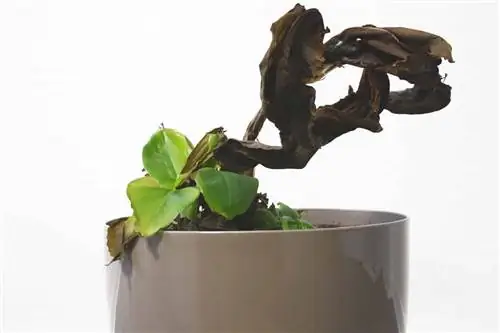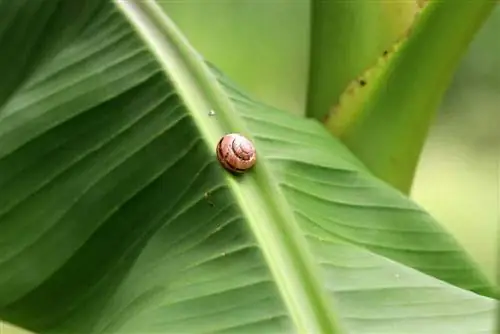- Author admin [email protected].
- Public 2023-12-17 03:39.
- Last modified 2025-01-24 12:45.
The banana plant has been enjoying increasing popularity as a houseplant in these latitudes for several years. Caring for the decorative Musa is quite uncomplicated, but it must be given a certain amount of space, because the tropical perennials can become very large and sprawling even in the apartment. The perennial banana is not hardy and should therefore always be cultivated in a bucket.
Location
If the banana plant is given the ideal location, it will thank you for it with a long life. When choosing the right location, the main thing to pay attention to is that it cannot tolerate any drafts. However, the chosen location must be able to provide sufficient brightness. The suitable locations for the banana plant in a living room could look like this:
- in a bright corner of the room
- right next to a south window
- East or west windows are also suitable
- next to a patio or balcony door
- Outdoors protected from the wind in summer
- Do not expose young plants to direct sun
- Humidity should be at least 50%
If it is not bright enough for the banana plant in the room, for example even during the dark season, then a plant lamp that is aimed directly at the perennial can also help. In addition to the brightness, this also has the advantage that the plant is displayed decoratively in the room.
Tip:
The Musa must be placed outdoors on a terrace or balcony protected from the wind, otherwise the leaves could tear.
Plants
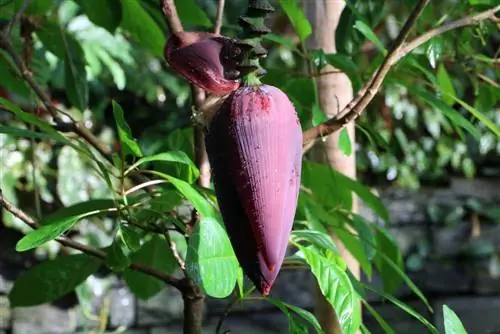
Banana plants in pots are available in various sizes in well-stocked garden shops. However, since the substrate used may be old or no longer contain enough nutrients, it is always advisable to plant the newly purchased plant in a suitable container as soon as possible. You should proceed as follows:
- Create drainage to prevent waterlogging
- Potter shards, expanded clay or stones over the drain hole
- here plant fleece
- fill in part of the earth
- Carefully remove the plant from the old pot
- insert and fill in remaining soil
- Put the pot on the ground a few times
- this is how the earth is distributed better
- water lightly
- Drain the collecting plate after half an hour
Tip:
The container for the banana plant should not be too big, otherwise the perennial could grow unhindered and become very large. The desired size of the decorative plant can be influenced, especially with the container.
Substrate & Soil
The Musa does not place great demands on the substrate. All soils are suitable for her as long as they are well permeable to water. Because the perennial cannot tolerate waterlogging and can lead to its death. This means that commercially available soil for potted plants can be used for the plants cultivated in the container.
Pouring
Watering the banana plant requires a little sensitivity. Because it must not receive too much or too little water. Standing moisture should be avoided at all costs. But the plant also does not tolerate drought well, especially in hot summers. When watering, pay attention to the following:
- water with lime-free rainwater
- alternatively use filtered tap water
- Do a finger test on earth
- If the soil is still moist, avoid watering
- do not leave water in the saucer
- A moisture meter is suitable for the banana tree
- the bigger the leaves, the more water
- dry leaf edges means lack of water
Tip:
Since the banana tree wants high humidity, it should be sprayed daily with lime-free water. A humidifier placed near the plant is also helpful.
Fertilize

The banana plant cultivated indoors is fertilized all year round. However, it is important to ensure that it receives weekly fertilization from spring to autumn. It can then be fertilized monthly in winter. A special liquid fertilizer for banana trees from well-stocked garden shops is suitable for the perennial.
Cutting
The Musa does not need pruning. However, if it becomes too large, individual, very large and spread-out leaves may have to be removed. If the perennial is dormant in a cool, dark room, it can also be cut back to the base. It will then sprout again the next spring with new leaves. Otherwise, the following should be noted here:
- remove yellow leaves
- Remove leaves with brown spots
- removing wind-torn leaves
The leaves are cut off directly at the base with a sharp knife. The cutting tool you choose should always be sharp and disinfected. Pure alcohol from the pharmacy or a special product from a gardening store can be used for disinfection.
Repotting
The Musa grows very quickly, so it sometimes needs a larger container. So it can be repotted every year. The right time to do this is immediately after winter, before the plant sprouts new leaves again. However, you should only choose a slightly larger pot, otherwise the banana will quickly become too big. When repotting, proceed as explained under “Planting”.
Tip:
Since the banana plants get bigger over the years and can reach an impressive height, it is a good idea to repot them with two people. This means that one person can remove the plant from the old container upwards while the other carefully pulls the container downwards.
Propagate
Banana plants usually reproduce by themselves because they form offshoots, the so-called kindles. These grow directly from the base. The main advantage of propagation through cuttings is that these are already finished plants that only need to be separated and placed in their own pot. The propagation proceeds as follows:
- Easy to do when repotting
- here the offshoots can be easily removed
- cut right at the base
- use a sharp and disinfected knife
- Place cuttings in pot with soil
- directly to new location
- bright and warm
- Keep soil moist
- new roots appear quickly
Tip:
Propagation through the offshoots is easy and quick. Especially if the existing banana tree is older, it is worth propagating it. Because if it is at an age where it could bear fruit, it will die after the first fruit formation.
Sowing

The Musa can be sown very easily. The seeds for this are commercially available. Of course, with this process it takes longer for the plant to grow large. But for hobby gardeners it is often a joy to see how the small plants slowly grow. When sowing the banana plant, you should proceed as follows:
- Fill pot with peat-sand mixture
- Place seeds lightly in soil
- Keep soil moist
- Cover the container with transparent foil
- alternatively use PET bottle
- cut off the neck of the bottle
- place upside down over the pot
- ventilate well every day
The pots with the seeds need a bright and warm location; temperatures of over 25° Celsius are ideal. You can also use a heating lamp to help here. Once the first seedlings have appeared, the cover is removed. When the small plants get bigger, they are transplanted into their own pots and kept warm and bright. You should now start spraying the leaves with water.
Wintering
Even if the banana plant is a year-round houseplant in this latitude, it still needs different treatment and a certain amount of hibernation in winter. The warm living room is not the suitable location for this. When it comes to overwintering, however, it always depends on the type of Musa. However, the following is important for all varieties when overwintering:
- Enough light and brightness even in winter
- also with plant lamp
- Temperature at around 10° Celsius
- bright staircase ideal
- unheated winter garden
- the darker the room, the colder
- always frost-free
- not colder than 5° Celsius for a longer period of time
The colder and darker it is, the less water the plant needs. The banana plant should be cut back, especially for a dark winter location. To do this, all leaves of the perennial are removed. As soon as the plant is made brighter and warmer again, it will sprout again.
Tip:
If the banana plant is moved to a dark and cold winter location in winter and cut back beforehand, then growth can be curbed in this way. During the growing season, the plant can move to a location in the apartment that doesn't offer as much space.
Fruit formation
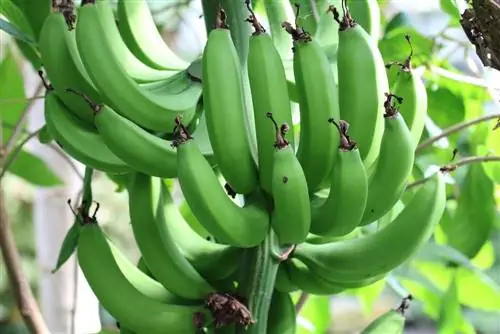
Depending on the variety of banana plants, fruit can form on the perennials. These ripen without pollination and can therefore also form on the rhizome responsible for pure houseplants. But it usually takes many years. The location and care conditions must also be optimal for this. Unfortunately, the plant dies once it has produced fruit. But it can be easily propagated beforehand thanks to its children.
Care errors, diseases or pests
If the leaves turn brown at the edge or all over, then this is a sign that the plant is not feeling well. The brown leaves either indicate a lack of water or low humidity can also be the cause. The brown leaves should be removed as they weaken the plant. Water and spray the plant sufficiently immediately. It is also helpful to set up a humidifier in close proximity to the Musa. The following pests can also attack the banana plant:
- Spider mites
- Mealybugs
- usually infested in winter quarters
- if plant is too dry
- if the room is very cool
- check the plant regularly
- Use insecticide
- wash the leaves with a damp cloth
- Water plants more often and increase humidity
- make it a little warmer
Tip:
If there is no other room for overwintering, a heat lamp can also help here, as it can slightly increase the temperature around the plant.

